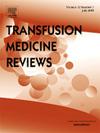定量与红细胞ABO不相容输血相关的危害:对英国SHOT文献的系统回顾
IF 2.5
2区 医学
Q2 HEMATOLOGY
引用次数: 0
摘要
abo血型不相容(ABOi)的红细胞(RBC)输注可导致严重的临床后果,包括患者死亡。开发了诸如床边电子输血检查(BETC)等电子系统,以降低由于床边患者识别错误而发生这些严重事件的风险;然而,对患者的益处尚未完全量化。为了解决这一差距,我们旨在量化英国与ABOi红细胞输血相关的危害(即发病率和死亡率),使我们能够更好地了解BETC在预防患者这些事件方面的益处。2名独立审稿人采用系统评价方法对27年来提交给《输血严重危害》(SHOT)的病例中已发表的英国血液警戒数据进行了评价,包括1996年至2023年的报告。数据被整理到Microsoft Excel数据库中以供进一步分析。对数据进行分析,以确定ABOi RBC输血报告的数量以及与这些事件相关的死亡率/发病率。发病率定义为溶血性输血反应(急性和延迟)、任何器官损伤、住院时间延长、需要机械通气和国际电联住院(包括重症监护病房),以及每种病例报告的任何其他不良事件。在27年(1996-2023年)期间,英国共发放了5530万个RBC单位,其中368例abo血型不相容(ABOi)输血,相当于每10万次输血中有0.67例。临床错误占观察到的ABOi输血的53.3%(0.36 / 10万),主要发生在给药(0.16 / 10万)、采血(0.10 / 10万)和样本采集(0.07 / 10万)期间。实验室错误占观察到的ABOi输血的13.6%(0.09 / 100,000),主要是输血前检测错误的结果(0.06 / 100,000)。观察到的ABOi输注死亡率为6.3%(0.04 / 10万),主要发病率为23.9%(0.16 / 10万),其中包括ICU入院(0.03 / 10万)和溶血反应(0.05 / 10万)。虽然ABOi红细胞输血在英国已经变得罕见,但它们与显著的短期发病率和死亡率相关。早期的SHOT报告缺乏标准化,提供的患者预后数据有限。当报告患者结果时,它仅限于ABOi输血后立即的短期结果。没有关于长期患者结果的数据报道,限制了提供长期结果评估的能力。加强血液警惕性对于降低ABOi风险至关重要。世界各地的国家血液警戒计划需要统一/标准化ABOi红细胞输血的短期和长期结果数据收集报告,以便我们更好地了解这些事件对患者的风险和负担。本文章由计算机程序翻译,如有差异,请以英文原文为准。
Quantifying Harms Associated With Red Cell ABO Incompatible Blood Transfusion: A Systematic Review of the UK SHOT Literature
ABO-incompatible (ABOi) red blood cell (RBC) transfusions can lead to severe clinical consequences, including patient death. Electronic systems, such as Bedside Electronic Transfusion Checks (BETC), have been developed to lower the risk of these serious incidents occurring due to errors in patient identification at the bedside; however, the benefits for patients have not yet been fully quantified. To address this gap, we aimed to quantify the harms (ie, morbidity and mortality) associated with ABOi RBC transfusions in the UK, enabling us to better understand the benefits of BETC in preventing these events for patients.
Twenty-seven years of published UK hemovigilance data from cases submitted to Serious Hazards of Transfusion (SHOT), including reports from 1996 to 2023 were reviewed using systematic review methodology by 2 independent reviewers. Data was collated into a Microsoft Excel database for further analysis. The data were analyzed to determine the number of reports of ABOi RBC transfusion and the rate of mortality/morbidity associated with these events. Morbidity was defined as hemolytic transfusion reaction (acute and delayed), any organ injury, extended length of hospital stays, the requirement for mechanical ventilation and ITU admission (including critical care units), and any other adverse events as reported in each case.
Over 27 years (1996-2023), 55.3 million RBC units were issued in the UK, with 368 ABO-incompatible (ABOi) transfusions, equating to 0.67 per 100,000 transfusions. Clinical errors accounted for 53.3% of the observed ABOi transfusions (0.36 per 100,000), primarily occurring during administration (0.16 per 100,000), blood collection (0.10 per 100,000), and sample collection (0.07 per 100,000). Laboratory errors made up for 13.6% of the observed ABOi transfusions (0.09 per 100,000), predominantly being a consequence of errors in pretransfusion testing (0.06 per 100,000). Mortality among the observed ABOi transfusions was 6.3% (0.04 per 100,000), with major morbidity at 23.9% (0.16 per 100,000), which includes ICU admissions (0.03 per 100,000) and hemolytic reactions (0.05 per 100,000).
While ABOi RBC transfusions have become rare in the UK, they are associated with significant short-term morbidity and mortality. Early SHOT reports lacked standardization and provide limited data on patient outcome. When patient outcome was reported, it was limited to short-term outcomes immediately post ABOi transfusions. No data was reported on longer -term patient outcomes limiting the ability to provide long-term outcome assessment. Enhancing hemovigilance practices is essential to reducing ABOi risks. National hemovigilance schemes worldwide need to harmonize/standardize the reporting of short-term and long-term outcome data collection for ABOi RBC transfusions so we can better understand the risk and burden of these events on patients.
求助全文
通过发布文献求助,成功后即可免费获取论文全文。
去求助
来源期刊

Transfusion Medicine Reviews
医学-血液学
CiteScore
11.60
自引率
0.00%
发文量
40
审稿时长
21 days
期刊介绍:
Transfusion Medicine Reviews provides an international forum in English for the publication of scholarly work devoted to the various sub-disciplines that comprise Transfusion Medicine including hemostasis and thrombosis and cellular therapies. The scope of the journal encompasses basic science, practical aspects, laboratory developments, clinical indications, and adverse effects.
 求助内容:
求助内容: 应助结果提醒方式:
应助结果提醒方式:


